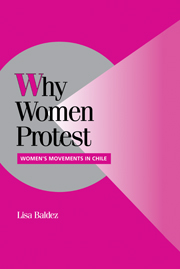Book contents
- Frontmatter
- Contents
- List of Figures and Tables
- Preface
- 1 WHY WOMEN PROTEST: TIPPING, TIMING, AND FRAMING
- 2 MOTHERS OF THE COLD WAR, DAUGHTERS OF THE REVOLUTION: A HISTORICAL OVERVIEW OF WOMEN AND CHILEAN POLITICS
- Part One Women Against Allende
- Part Two Women Against Pinochet
- 6 GENDERED NETWORKS AND THE REBIRTH OF CIVIL SOCIETY
- 7 WOMEN DEFEND LIFE: MASS PROTESTS AND THE WOMEN'S MOVEMENT
- 8 DEMOCRACY IN THE COUNTRY AND IN THE HOME: WOMEN FOR AND AGAINST DEMOCRATIC TRANSITION
- 9 WHY WOMEN PROTEST: COMPARATIVE EVIDENCE
- References
- Index
9 - WHY WOMEN PROTEST: COMPARATIVE EVIDENCE
Published online by Cambridge University Press: 06 July 2010
- Frontmatter
- Contents
- List of Figures and Tables
- Preface
- 1 WHY WOMEN PROTEST: TIPPING, TIMING, AND FRAMING
- 2 MOTHERS OF THE COLD WAR, DAUGHTERS OF THE REVOLUTION: A HISTORICAL OVERVIEW OF WOMEN AND CHILEAN POLITICS
- Part One Women Against Allende
- Part Two Women Against Pinochet
- 6 GENDERED NETWORKS AND THE REBIRTH OF CIVIL SOCIETY
- 7 WOMEN DEFEND LIFE: MASS PROTESTS AND THE WOMEN'S MOVEMENT
- 8 DEMOCRACY IN THE COUNTRY AND IN THE HOME: WOMEN FOR AND AGAINST DEMOCRATIC TRANSITION
- 9 WHY WOMEN PROTEST: COMPARATIVE EVIDENCE
- References
- Index
Summary
It is common to think of women's movements, particularly those in the West, in terms of three phases of development: a first-wave movement centered on the demand for suffrage, followed by period of relative quiescence, and then a second-wave women's movement focused on women's equality. This approach predominates within contemporary historiography of women's movements. In Chile, for example, the first-wave movement began when women organized around the right to vote in the late 1800s and ended when women won full voting rights in 1949. Next came a period characterized by a dearth of mobilization among independent women's organizations, which Chilean scholar Julieta Kirkwood (1986) called “the feminist silence.” The second-wave women's movement began in the 1970s and remains active today. A similar pattern characterizes women's mobilization in the United States. The suffrage movement began with the Seneca Falls Convention in 1848 and ended with the nineteenth amendment in 1920, and the second-wave movement began in the late 1960s and continues to the present day. Women did not altogether retreat from public life in the forty-year period between the first- and second-wave movements, as recent scholarship has shown (Andersen 1996; Mettler 1998; Wolbrecht 2000). Yet relatively low levels of organizing among women prompted Leila Rupp and Verta Taylor (1987) to refer to this period as “the doldrums.”
I invoke the categorization of movements into first and second wave as a way to return to the starting point of this book: some periods foster the mobilization of women and others do not. This book seeks to identify those conditions. To do so, my approach centers on three relatively straightforward concepts: tipping, timing, and framing.
- Type
- Chapter
- Information
- Why Women ProtestWomen's Movements in Chile, pp. 196 - 208Publisher: Cambridge University PressPrint publication year: 2002

